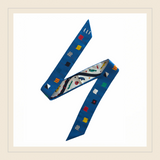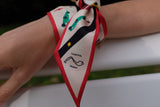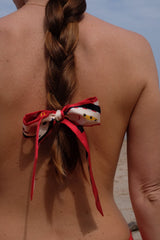AN ENTHUSIASTIC ILLUSTRATOR
Cradled by the sun and the beaches of southeastern France, this young illustrator grew up with her head full of pop colors! Today, she lives in Paris where the summer waves of her childhood constantly influence her work and her good mood. After having proven itself for other major brands, it welcomed a collaboration with Monoïkos 1297 with enthusiasm.
A note of history
The Monaco Grand Prix is one of the oldest and most prestigious races in the world.
Created in 1929 by Antony Noghès, the Monaco circuit, designed in the middle of the city, has maintained almost its entire original layout, a narrow and winding track, which makes it one of the most demanding circuits on the Formula 1 World Championship calendar.
The Monaco circuit is 3.367 km long.
The start is from the Port Hercule, then it winds through the streets of Monte Carlo and La Condamine, taking tight turns in the middle of guard rails: the track is narrow and demanding and makes overtaking difficult.
After the start line, the drivers go up the Boulevard Albert Ier and hurry through the first right-hand turn of "Sainte Dévote", the scene of many collisions in the first lap. They then start the very steep climb up "Beau-Rivage" to the very tight left-right of "Casino". From there, the drivers go down to the right turn of "Mirabeau", then comes the left hairpin "Grand Hotel", the slowest turn of the championship. The "Portier" section then leads to the sea and the drivers go through the tunnel that leads to the chicane near the port. At the exit of the tunnel, the fastest section of the circuit, the cars are approaching 300 km/h. After a short straight on the "Quai des États-Unis", comes the left turn of the "Bureau de Tabac", the left-right section of the "Piscine" and then a very difficult right hairpin at "La Rascasse". Finally, the drivers tackle the "Anthony Noghès" turn before the pit lane and the finish.
This is certainly one of the most demanding circuits on the Formula 1 World Championship calendar. It is the most glamorous, the most prestigious, the most popular and above all the one that every driver and every team wants to win!
A product of exception
A technological feat that reveals the most delicate details
the most delicate details and the most demanding motifs in colour.
Its box, the red colour of Monaco, is made in the Principality from FSC-certified paper from responsibly managed forests.
The mischievous Grand Prix is part of the ephemeral "Grand Prix" collection, a clever silk ribbon that illustrates in drawings a major event in the Principality of Monaco.
The silk
This precious shiny filament, obtained by unwinding the cocoon of a silkworm, naturally requires very high quality production conditions.
Very sensitive to the quality of the environment, the silkworm does not tolerate pollution and feeds only on fresh leaves. Its breeding requires a know-how of excellence: our craftsmen have selected the best silk farms.
Preserve the beauty of your Malicieux. Store it flat and untied or in its original box rolled up. Avoid contact with your perfume. Entrust its cleaning to a specialized professional.











